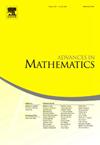子空间配置和曲线上的低度点
IF 1.5
1区 数学
Q1 MATHEMATICS
引用次数: 0
摘要
本文致力于理解数域 k 上的曲线 X,它在度数至多为 d 的 k 的广延中有无穷多个解;这些解就是所谓的低度点。对于 d=2,3 已知([9], [2]),这类曲线在基数变为 k‾ 之后,可以有一个至多 d 度的映射到 P1 或椭圆曲线上。对于 d⩾4,类似的说法被证明是错误的[3]。我们证明,一旦 X 的种属足够高,低度点仍然具有几何起源:它们可以作为低度点从较低种属曲线的回拉而得到。我们引入了附加于此类曲线的离散几何不变量:具有许多有趣性质的子空间配置族。这种结构为 [3] 中的曲线提供了一种自然的替代构造。作为我们方法的应用,我们得到了 d=2,3 时 k 上的此类曲线分类,以及 d=4,5 时 k¯ 上的分类。本文章由计算机程序翻译,如有差异,请以英文原文为准。
Subspace configurations and low degree points on curves
This paper is devoted to understanding curves X over a number field k that possess infinitely many solutions in extensions of k of degree at most d; such solutions are the titular low degree points. For it is known ([9], [2]) that such curves, after a base change to , admit a map of degree at most d onto or an elliptic curve. For the analogous statement was shown to be false [3]. We prove that once the genus of X is high enough, the low degree points still have geometric origin: they can be obtained as pullbacks of low degree points from a lower genus curve. We introduce a discrete-geometric invariant attached to such curves: a family of subspace configurations, with many interesting properties. This structure gives a natural alternative construction of curves from [3]. As an application of our methods, we obtain a classification of such curves over k for , and a classification over for .
求助全文
通过发布文献求助,成功后即可免费获取论文全文。
去求助
来源期刊

Advances in Mathematics
数学-数学
CiteScore
2.80
自引率
5.90%
发文量
497
审稿时长
7.5 months
期刊介绍:
Emphasizing contributions that represent significant advances in all areas of pure mathematics, Advances in Mathematics provides research mathematicians with an effective medium for communicating important recent developments in their areas of specialization to colleagues and to scientists in related disciplines.
 求助内容:
求助内容: 应助结果提醒方式:
应助结果提醒方式:


